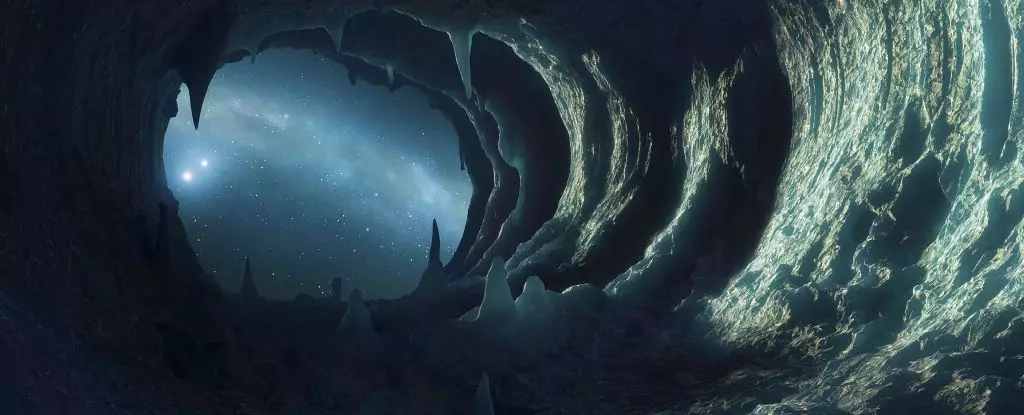For centuries, scientists have held a somewhat simplistic view of water in the cosmos. The prevailing assumption was that in the frigid, cold vacuum of space, water would predominantly exist as amorphous, disordered ice — a glassy, unstructured jumble of molecules silent in its complexity. However, groundbreaking research reveals a more intricate portrait: space ice is not a uniform, featureless substance but rather a composite of tiny crystalline structures embedded within amorphous ice. This revelation challenges deeply rooted notions and opens new avenues for understanding the physics of the universe.
This discovery underscores an essential truth: cosmic water, much like the universe itself, is far more nuanced than our Earth-bound experiences suggest. The implications stretch across multiple domains of astrophysics, from planetary formation to galaxy evolution, emphasizing that water’s microstructure plays a crucial role in the grand cosmic dance. The presence of nanometer-scale crystals within space ice not only refines our models but also compels us to reconsider the processes that govern matter at the most fundamental levels.
Unveiling the Hidden Patterns: Crystallinity in the Cold Silence of Space
Historically, scientists presumed that the cold temperatures of space—often plunging below -100°C—ensured that water would freeze into amorphous forms, lacking the order that characterizes earthly ice. This belief was rooted in observations and the assumption that the low energy environment lacked the capacity for atoms to arrange themselves in ordered patterns. Yet, recent sophisticated computer simulations combined with laboratory experiments tell a different story.
By mimicking the conditions of space, scientists demonstrated that when water vapor deposits onto cold surfaces—a process known as direct vapor condensation—tiny crystalline regions can spontaneously form, even amid predominantly amorphous matrices. These structures are mere nanometers but hold significant sway over the behavior of cosmic ice. When the researchers gently warmed their simulated space ice, they observed shifts indicating that crystalline regions persisted, thus betraying the prior assumption that space ice is entirely disordered.
This finding is profound because it suggests that space ice is a hybrid material, a mosaic of amorphous and crystalline phases. It’s an intricate structure that could influence the way water interacts with other molecules, how ice particles coalesce to form planetary bodies, and how the physical properties of cosmic dust and ice determine the evolution of celestial objects.
Implications for Cosmic and Technological Frontiers
The recognition that tiny crystals are likely embedded within space ice alters our understanding of numerous astrophysical processes. For instance, in the context of planet formation, ice-rich grains act as building blocks. Microcrystalline structures could influence how these grains stick together, possibly accelerating or hindering planetesimal creation. Similarly, the presence of ordered regions within amorphous ice could affect the sublimation processes that regulate how water vapor returns to space, thus impacting the lifecycle of comets and icy moons.
Beyond astrophysics, this research resonates with fundamental materials science and engineering. The realization that amorphous phases can retain crystalline traces has significant implications for the development of advanced materials. Glasses and amorphous semiconductors, for example, could contain similar hidden structures, affecting their electrical and mechanical properties. Understanding space ice’s microstructure may inspire innovations in optical fibers, memory storage, and other technologies reliant on amorphous materials — all of which hinge on the delicate balance between order and disorder.
Furthermore, this research neutralizes the notion that crystalline ice is exclusive to Earth-like environments with abundant liquid water. Instead, it suggests that even in the stark darkness of space, the fundamental principles of molecular organization persist at the smallest scales, where the deterministic order of crystals subtly infiltrates what appears to be a disordered landscape.
A Paradigm Shift: Questions and Opportunities
The evidence of nanocrystalline zones within space ice prompts an invigorating re-examination of long-held assumptions. It challenges planetary scientists investigating icy moons, trojans, and comets to reconsider how they interpret observational data. If tiny, persistent crystals are widespread, then the properties and evolution of these icy bodies could be markedly different from prior models.
Moreover, this insight invites a broader philosophical reflection: How much hidden complexity do the universe’s simplest substances harbor? Water—a substance essential to life—may be more structurally versatile at cosmic scales than in terrestrial settings. Understanding these microstructural subtleties could also influence the search for extraterrestrial life. If water in space retains ordered regions, perhaps under certain conditions they foster the chemistry necessary for life, making the universe an even more hospitable place than previously imagined.
As research advances, humanity stands at the threshold of decoding the subtle architectures that underpin the cosmos. These tiny crystals in space ice aren’t mere structural curiosities; they are keys to unlocking the universe’s most profound mysteries about matter, energy, and life’s potential cradle among the stars.

